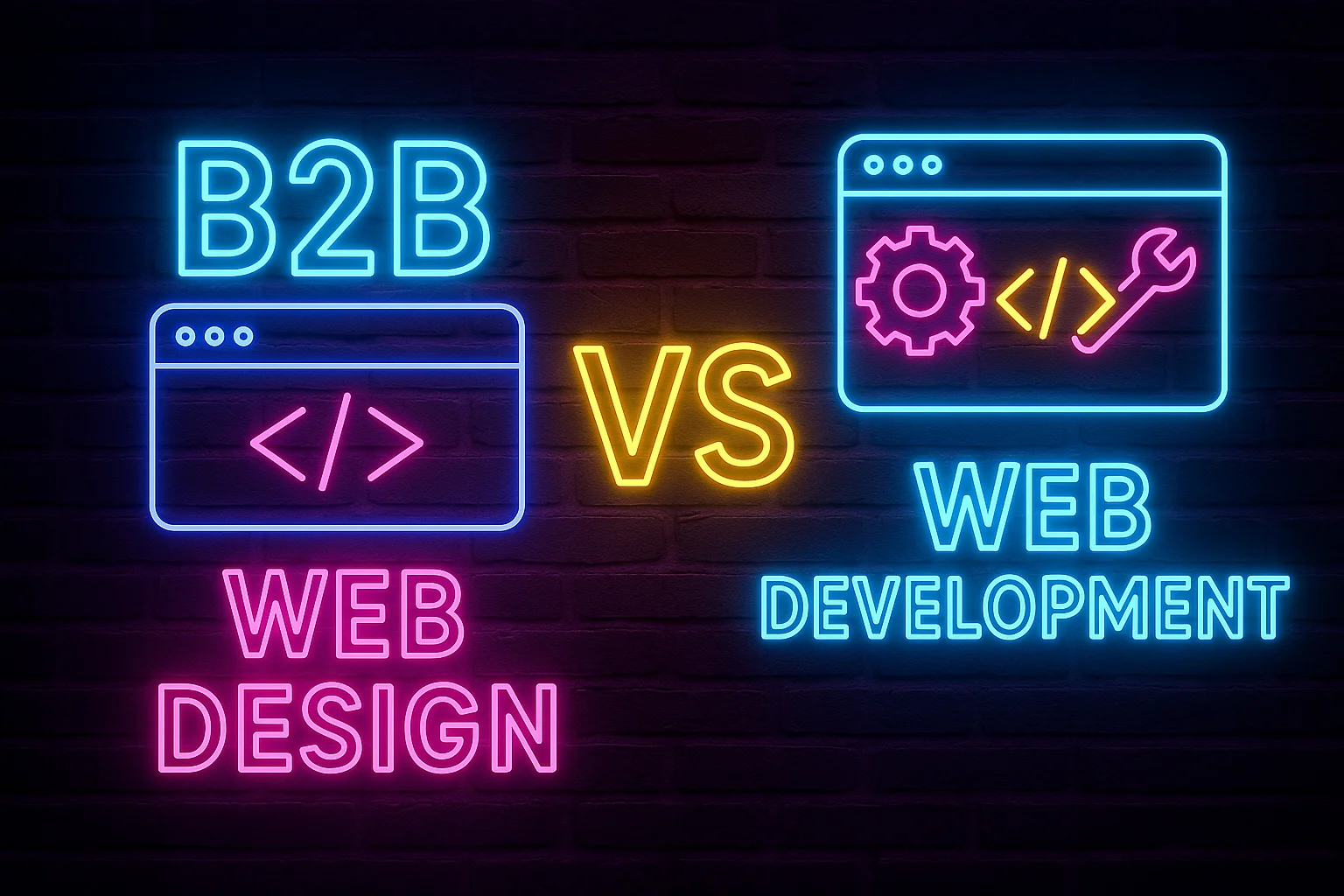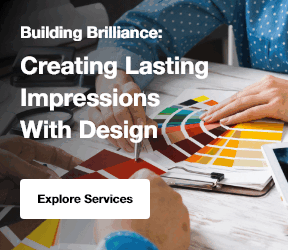Creating a successful B2B website requires a clear understanding of B2B Web Design vs Web Development, as both serve distinct purposes and complement each other.
While design focuses on visual appeal and user experience—layout, colors, typography, and intuitive navigation—development handles the site’s functionality, performance, and responsiveness.
A well-designed website makes a strong first impression, keeps visitors engaged, and encourages actions like sign-ups or demo requests.
Meanwhile, web development ensures smooth operation across devices, fast loading times, and integration with tools like CRMs, payment gateways, and marketing platforms.
Together, design and development create a seamless website experience: design attracts and engages users, while development guarantees functionality and reliability.
This combination is key to driving conversions, fostering client trust, and establishing a competitive edge in the B2B digital landscape.
What is B2B Web Design?
B2B web design, a core element in B2B Web Design vs Web Development, refers to the process of creating the user interface (UI), layout, and visual elements of a business website tailored for other businesses,, often integrated with B2B Web and Design Development strategies, much like How to Launch a New Product integrates marketing and strategy.
Unlike B2C websites, understanding B2B Web Design vs Web Development alongside, the importance of web design for B2B companies, B2B vs B2C web design focuses on meeting the specific needs of business clients, ensuring that the website is not only visually appealing but also functional, professional, and optimized for business interactions.
1. User Interface (UI) and Layout
B2B web design focuses heavily on a clean and professional UI, where every element, from buttons to images, is aligned with the business’s branding and goals.
The layout should be designed to present information in a clear and easily digestible way, enabling users to find key details about products, services, or solutions quickly.
2. Brand Consistency Across Pages
A consistent brand identity is critical in B2B web design. From the color scheme to typography, and logo placement, the design across all pages should align with the company’s brand guidelines. When considering this, how do I choose a web design agency for my corporate website plays an important role in selecting the right agency for your needs.
This consistency helps build trust and credibility, reinforcing the brand’s identity and making the website more recognizable and professional to clients.
3. User Experience (UX) Elements
Ensuring a great user experience (UX) is central to B2B web design. The website should be intuitive, fast, and easy to navigate to minimize frustration and keep potential clients engaged.
UX design focuses on optimizing site performance, including quick load times, responsive design for mobile and desktop users, and clear navigation paths to help visitors find relevant content or products.
Explore Our B2B Web Design & Development Services
What is B2B Web Development?
B2B web development, often part of Custom Web Application Services, refers to the technical process of building and maintaining the underlying structure and functionality of a business-to-business website, including Mobile Design & Development Services for multi-device optimization, while considering what are some benefits of the Agile Development Methodology for flexible and iterative improvements.
It encompasses both backend and frontend development to ensure a seamless, efficient, and secure user experience.
-
Backend Functionality: Involves databases, server-side scripting, and APIs to manage data and ensure smooth communication between the server and the website. This ensures that the site can process requests, store information, and perform business logic.
-
Scalability and Security: B2B web development focuses on ensuring that the website is scalable to handle future growth and can accommodate high traffic volumes. Security is also a priority to protect sensitive business data and maintain compliance with industry regulations.
-
Frontend Development: Converts design elements into interactive, functional code using languages like HTML, CSS, and JavaScript. This ensures that the site is visually engaging, responsive, and works across all devices
Key Differences Between Web Design and Development
Here are some of the main key differences:
1. Focus
Some aspects of focus for Web Design and Web Development are:
-
For Web Design
The primary focus of web design is on the visual aspects of the website, making it aesthetically appealing and ensuring an intuitive user experience (UX).
Designers aim to craft a visually engaging layout, select appropriate colors, typography, and images, and structure content in a way that guides users easily through the site.
The design needs to resonate with the brand identity while prioritizing usability and navigation.
-
For Web Development
While design focuses on how the site looks, web development is centered on how the site works. Developers are responsible for building the underlying structure and functionality of the website.
This includes creating the backend, which handles data processing, managing servers, setting up databases, and ensuring that the site can function at scale.
Development also involves frontend development, which transforms the design into a functional website by writing code that interacts with users and responds to their actions.
2. Skills Required
Some Skills Required For Web Desigining and Development are:
-
Web Designers
Designers are experts in graphic design, UI (User Interface), and UX (User Experience) design.
Their skill set includes the ability to create visual assets, wireframes, prototypes, and layouts that align with the company’s branding. Designers use creative tools like Figma, Adobe XD, and Sketch to bring their concepts to life.
-
Web Developers
Developers, on the other hand, are skilled in coding languages and programming. They write the scripts that make the website interactive and functional.
Frontend developers use languages like HTML, CSS, and JavaScript to implement the visual design elements and make the site responsive and interactive.
Backend developers handle server-side scripting using languages such as PHP, Python, and Ruby to manage databases, handle client requests, and ensure the site runs smoothly.
3. Tools
Tools used for designing and development are:
-
Design Tools include Figma, Adobe XD, and Sketch, used for creating wireframes, prototypes, and UI designs.
-
Development Tools include VS Code, GitHub, and databases, used for coding, version control, and managing data.
Here’s a quick comparison chart highlighting the key differences between Web Design and Web Development:
|
Aspect |
Web Design |
Web Development |
|
Focus |
Visual aesthetics, branding, user experience (UX), and intuitive navigation |
Functionality, structure, performance, and how the website works |
|
Skills |
Graphic Design, UI/UX, wireframing, prototyping, branding |
Coding, problem-solving, database management, server handling |
|
Tools |
Figma, Adobe XD, Sketch |
VS Code, GitHub, Databases, Command Line Tools |
|
Frontend Role |
Creating layouts, selecting colors, typography, images, and designing user-friendly interactions |
Converting designs into functional sites with HTML, CSS, JavaScript |
|
Backend Role |
Not applicable |
Building server-side logic, APIs, databases using PHP, Python, Ruby, Node.js, etc. |
|
Goal |
Make the website look appealing and ensure a smooth user experience |
Make the website run smoothly, securely, and handle data/requests efficiently |
Explore Our B2B Marketing Services
How They Work Together for a Successful B2B Website?
Designers and developers work closely together to create a successful B2B website, combining their creative and technical expertise.
Designers begin by creating mockups and prototypes that act as blueprints, providing a clear visual representation of how the website should look and function.
These designs outline the layout, color schemes, typography, and overall aesthetic, ensuring the website aligns with the brand’s identity.
Developers then take these designs and transform them into a fully functional website, writing code to bring the visual elements to life.
Both teams collaborate closely to ensure that the website is responsive and optimized for usability across various devices, including desktops, tablets, and mobile phones, especially when implementing how does Shopify work features for e-commerce integration.
This ensures a seamless, consistent, and intuitive user experience, no matter the device. By combining design and development, the teams create a B2B website that is not only visually appealing but also highly functional and user-friendly, offering an optimal experience for business clients, while considering what are five marketing strategies that retailers spend half of their annual budget on? for B2B engagement.
How Both Are Equally Important for B2B Websites?
B2B Web Design vs Web Development play equal roles in the success of a B2B website, each contributing in different but complementary ways, supporting B2B Marketing Services and measurable outcomes like Google Ads cost optimization.
-
Web Design: It directly influences first impressions, as a well-designed website immediately conveys professionalism and trustworthiness. Good design enhances user engagement, making the website more visually appealing and easier to navigate, which in turn boosts conversion rates by guiding users through the sales funnel effectively.
-
Web Development: While design focuses on appearance, development ensures the website’s functionality, speed, security, and overall performance. These elements are vital for building a reliable platform that businesses can trust for transactions. A smooth, fast, and secure website is essential for maintaining client confidence and facilitating seamless business operations.
Together, both web design and development are necessary to create a B2B website that is not only visually engaging but also performs reliably, ensuring a positive user experience and fostering long-term business relationships.
Conclusion
Both web design and web development are integral to the success of a B2B website.
While design focuses on creating a visually appealing and engaging experience, development ensures the website’s functionality, speed, and performance.
By combining strong design with solid development, businesses can create a website that is not only aesthetically pleasing but also high-performing and user-friendly, offering a seamless experience that drives engagement, conversions, and long-term success.









